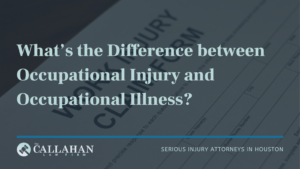Occupational Injury vs Occupational Illness: What’s the Difference?

Workplace accidents and illnesses affect more than 340 million workers worldwide each year, and without proper awareness of the dangers of occupational illness and occupational injury, employers and employees will add to this statistic.
What is Occupational Injury?
Occupational injury refers to physical harm or damage sustained by an employee while carrying out their job responsibilities. These injuries are often unexpected and suddenly disrupt employees’ work and personal life.
Examples of occupational injuries include falls, cuts, burns, fractures, spinal injuries, and sprains. They can result from accidents, equipment mishandling, slips, trips, or other unforeseen incidents that cause immediate harm.
Common Causes of Occupational Injuries
Several factors contribute to the occurrence of occupational injuries. Some common causes include:
1. Falls
Slipping, tripping, or falling from heights can lead to injuries such as sprains, fractures, or head trauma. Factors that contribute to falls include slippery surfaces, uneven floors, improper footwear, or lack of fall protection measures.
2. Machinery Accidents
Working with heavy machinery or equipment poses a risk of injuries, such as crushing, amputation, or lacerations. Inadequate training, lack of safety guards, or mechanical failures can contribute to these accidents.
3. Overexertion
Physical strain from lifting, pushing, or pulling heavy objects can result in muscle strains, back injuries, or hernias. Poor ergonomics, improper lifting techniques, or excessive work demands can contribute to overexertion injuries.
Types of Occupational Injuries
Occupational injuries can be categorized according to their nature and causes. Some common types include:
Traumatic Injuries
Traumatic injuries are caused by sudden and forceful incidents, such as falls, collisions, or accidents involving machinery. Examples include fractures, sprains, concussions, or cuts.
Repetitive Motion Injuries
These injuries result from repetitive movements or overuse of certain body parts. Examples include carpal tunnel syndrome, tendonitis, or bursitis, often seen in occupations requiring repetitive tasks like typing, assembly line work, or manual labor.
Overexertion Injuries
Overexertion injuries occur due to excessive physical effort or strain. This can include lifting heavy objects, pulling, or pushing. Strained muscles, hernias, or back injuries are common examples of overexertion injuries.
As you can see, occupational injuries can vary widely depending on the industry and job roles. Now, let’s take a look at occupational illness.

What is Occupational Illness?
Occupational illness encompasses health conditions that develop over time due to prolonged exposure to hazards or harmful substances present in the workplace. Unlike occupational injuries, these illnesses may not manifest immediately and can take months or even years to develop.
Occupational illnesses can result from exposure to toxic chemicals, harmful fumes, noise pollution, repetitive motions, or ergonomic issues. Common examples of occupational illnesses include respiratory diseases, skin disorders, and hearing loss.
Common Causes of Occupational Illnesses
Occupational illnesses can be attributed to various workplace hazards and substances. Some common causes include:
Hazardous Chemicals
Exposure to toxic chemicals or substances like asbestos, lead, solvents, pesticides, or heavy metals can lead to various occupational illnesses. These include respiratory diseases, cancer, neurological disorders, and organ damage.
Physical Hazards
Some occupational illnesses result from exposure to physical hazards such as excessive noise, vibrations, or radiation. Exposure to loud noise due to the environment can lead to hearing loss, while extended exposure to radiation can cause conditions like radiation sickness or cancer.
Ergonomic Factors
Poor ergonomics and repetitive movements can contribute to occupational illnesses such as musculoskeletal disorders, including carpal tunnel syndrome, tendonitis, or lower back pain.
Types of Occupational Illnesses
Occupational illnesses can manifest in different ways, affecting various body systems. Here are some common types of occupational illnesses:
Respiratory Illnesses
Exposure to airborne particles, fumes, or hazardous chemicals can lead to respiratory conditions such as industrial asthma, chronic obstructive pulmonary disease (COPD), or pneumoconiosis (e.g., coal worker’s lung or asbestosis).
Skin Disorders
Contact with irritants, allergens, or harmful substances can cause occupational skin diseases, including dermatitis, eczema, or chemical burns.
Hearing Loss
Exposure to excessive noise levels without proper hearing protection can result in occupational hearing loss or tinnitus.
Recognizing the causes, types, and examples of occupational illnesses enables employers to implement preventive measures, such as proper ventilation systems, personal protective equipment (PPE), and regular health monitoring.
Employees can also actively protect themselves by following safety protocols, using protective gear, and promptly reporting any potential hazards or symptoms of occupational illnesses.
Occupational Injury vs. Occupational Illness: Key Differences

Understanding the differences between occupational injuries and occupational illnesses is crucial for effectively addressing and managing these issues in the workplace. While both can impact the well-being of employees, there are distinct factors that set them apart.
| Key Differences | Occupational Injury | Occupational Illness |
| Nature of the Condition | Physical harm. E.g. cuts, fractures, or sprains. | Workplace hazards. E.g. hearing loss, respiratory illnesses, cancer, etc. |
| Causes and Contributing Factors | Accidents. E.g., slips and falls, etc. | Exposure to harmful substances. E.g. Excessive noise, toxic chemicals, airborne particles, etc. |
| Onset and Duration | Immediate effect | Gradual effects often take months or years. |
| Treatment and Management | Immediate medical attention. | Long-term management and treatment. |
1. Nature of the Condition
Occupational injuries are immediate and result from sudden incidents or accidents at work. They cause physical harm or damage to the body, such as cuts, fractures, or sprains. On the other hand, occupational illnesses develop gradually over time due to prolonged exposure to workplace hazards or harmful substances. These illnesses affect employees’ overall health and well-being, often impacting specific body systems or organs.
2. Causes and Contributing Factors
Accidents, unsafe working conditions, or improper equipment handling typically cause occupational injuries. Factors such as slips, falls, machinery malfunctions, or overexertion can contribute to these injuries. In contrast, occupational illnesses are primarily caused by exposure to hazards or harmful substances in the workplace. These include toxic chemicals, airborne particles, excessive noise, and ergonomic issues. Over time, prolonged exposure to these factors increases the risk of developing occupational illnesses.
3. Onset and Duration
Occupational injuries have an immediate onset, occurring suddenly due to an incident or accident. The effects of these injuries can be observed and experienced shortly after the event. In contrast, occupational illnesses gradually begin with symptoms manifesting over an extended period. The effects of occupational illnesses may not be immediately apparent, often taking months or even years to develop and become noticeable.
4. Treatment and Management
Occupational injuries are often treated through immediate medical intervention, such as first aid, emergency care, or rehabilitation. The focus is addressing immediate physical harm and restoring the employee’s health. In contrast, occupational illnesses may require long-term management and treatment. This can involve medical interventions, lifestyle changes, or ongoing monitoring to manage the effects of the illness on the employee’s health.
Understanding these key differences between occupational injuries and occupational illnesses allows employers to implement appropriate preventive measures and safety protocols.
How Important is Prevention and Workplace Safety?
By understanding the significance of prevention and implementing effective workplace safety measures, employers and employees can ensure the well-being and productivity of all individuals involved.

Preventing occupational injuries and illnesses brings numerous benefits to both individuals and organizations:
- It safeguards employees’ physical health and well-being, reducing suffering and preserving their quality of life.
- Prevention measures contribute to a positive work environment, fostering employee morale, job satisfaction, and retention.
- Preventing injuries and illnesses can reduce healthcare costs for individuals and organizations, improving overall productivity and reducing downtime.
How to Implement Safety Measures and Regulations
Employers must establish robust safety measures and adhere to relevant regulations to prevent occupational injuries and illnesses. This includes:
- Conducting thorough risk assessments.
- Identifying and mitigating potential hazards.
- Providing appropriate personal protective equipment (PPE).
- Ensuring adequate employee training.
- Maintain clear communication channels.
- Encouraging employees to promptly report hazards, injuries, or symptoms of occupational illnesses.
Role of Employers and Employees in Maintaining a Safe Work Environment
Creating a safe work environment requires collaboration and participation from employers and employees. Employers must take a proactive approach by prioritizing employee safety, providing necessary resources, and fostering a safety culture within the organization. This includes:
- Promoting safety training programs.
- Enforcing safety protocols.
- Regularly evaluating and improving workplace conditions.
Employees should also play their role by adhering to safety guidelines, using protective equipment, and promptly reporting potential hazards or incidents.
A shared commitment to safety and constant communication is key to maintaining a secure work environment.
Have you suffered an occupational injury/illness?
Preventing both occupational injuries and illnesses is of paramount importance. It preserves the well-being of employees, fosters a positive work environment, and reduces healthcare costs and downtime. Employers play a pivotal role by implementing safety measures, adhering to regulations, and prioritizing employee safety. Employees, too, contribute by following safety protocols and promptly reporting potential hazards or incidents.
Organizations must invest in preventive measures, thorough risk assessments, adequate training, and open communication to create a safety culture. By doing so, they can minimize the risks of occupational injuries and illnesses and prioritize the health and safety of their workforce.
If you or your loved one have suffered some form of occupational injury or illness due to workplace hazards, you need a work injury lawyer. Contact The Callahan Law Firm lawyers today for a free case consultation.
FAQs
Q: What is the difference between illness and injury?
A: The main difference between illness and injury lies in their nature and manifestation. Illness refers to a health condition or disease that affects the overall well-being of an individual, often caused by factors like infections, exposure to harmful substances, or genetic predispositions. On the other hand, an injury refers to physical harm or damage to the body resulting from accidents, falls, or other sudden incidents.
Q: What is an occupational illness?
A: An occupational illness is a health condition that develops over time as a result of exposure to hazards or harmful substances in the workplace. These illnesses are associated with specific workplace factors such as chemical exposure, repetitive motions, ergonomic issues, or excessive noise levels. Occupational illnesses can affect various body systems and may have long-term consequences on an individual’s health.
Q: What is an occupational injury?
A: An occupational injury is a physical harm or damage to the body that occurs suddenly due to accidents or incidents in the workplace. These injuries range from minor cuts and bruises to severe fractures, sprains, or head trauma. Occupational injuries can happen due to slips, falls, machinery accidents, or overexertion while performing job-related tasks.
Q: What are examples of occupational injuries and illnesses?
A: Examples of occupational injuries include a construction worker falling from scaffolding and sustaining a broken arm, a chef cutting their hand while using a knife in the kitchen, a warehouse worker being hit by a forklift and suffering a leg fracture, or an office employee slipping on a wet floor and spraining their ankle.
Examples of occupational illnesses include a painter developing occupational asthma due to prolonged exposure to paint fumes and solvents, a factory worker developing contact dermatitis from frequent contact with chemicals in the manufacturing process, a construction worker experiencing hearing loss from continuous exposure to loud machinery without hearing protection, or an office worker developing carpal tunnel syndrome from repetitive typing and poor ergonomics.

Michael S Callahan is an attorney and founder of The Callahan Law Firm. He focuses his practice on representing individuals and families in personal injury cases involving motor vehicle and truck accidents, workplace accidents and defective products. With over 25 years of experience, he is dedicated to fighting on behalf of people whose lives have been forever altered by the negligence and carelessness of corporations and individuals. Originally trained as a mechanical engineer, Michael has been practicing law and fighting for justice for those who need it most since 1994. He is board-certified in Personal Injury Trial Law by the Texas Board of Legal Specialization and a member of various esteemed legal associations. Outside of work, Michael enjoys spending quality time with his family, outdoor activities, and continually striving to improve as a trial lawyer and human being.











